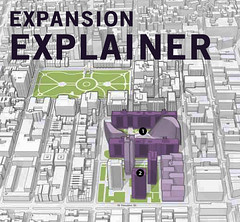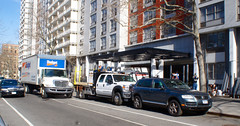As Village residents await Borough President Scott Stringer’s recommendation early next month regarding N.Y.U.’s expansion plans, The Local is taking a look at the impacts of the project. Today, we’re examining the concerns surrounding parking under the proposed development. Check back throughout the week for our coverage of concerns surrounding loss of light, the dog run, playgrounds, and the LaGuardia Community Garden. What other issues should we tackle? Let us know in the comments.
OK, so how is parking in Greenwich Village going to be affected by this plan?
Currently, there are 670 spaces in a garage underneath Washington Square Village. Of these, 150 are public and the rest, a total of 520, are reserved for residents and their guests. As proposed, 281 parking spaces will be permanently eliminated. No spaces will be available to the general public.
So, 281 lost? That sounds like a lot.
The new garage would have 389 total spaces, which is the minimum required by the city zoning code. The entirely private garage would be built starting in 2022 and would be accessible through only one entrance, whereas the existing one has two (on West Third and Bleecker Streets). The current garage operates at around 80-percent capacity, and has around 130 spaces available on a typical workday. N.Y.U. believes that the amount of traffic using the new garage will be significantly less than it is now, given that the lot will not be open to drivers regularly commuting into the area. Opponents like Terri Cude, co-chairwoman of the Community Action Alliance, argue that the single entrance and exit would create a choke point that would exacerbate traffic.
I’m having trouble visualizing 281 parking spaces.
On a recent Friday afternoon there were 56 cars parked on Bleecker Street between LaGuardia Place and Mercer Street, just south of Washington Square Village. So imagine all the cars parked on that block five times over.
Won’t this make traffic worse around Greenwich Village? There will be 281 more cars looking for parking!
According to the city-mandated environmental impact statement prepared by N.Y.U., there will be a parking shortfall on weekdays starting in 2031, when construction of the proposed project would be complete. William Haas, the university’s director of planning, said that parking is already at 84-percent capacity within a quarter-mile of Washington Square Village, so it is likely there will be a shortfall in the neighborhood in 20 years regardless of whether the project is approved.
The lack of parking does not constitute a significant adverse traffic impact, as defined by the city’s environmental quality review procedure, which allows for loss of spaces in areas with ample public transportation. (See page 16-65 of this document). Of course, others aren’t buying it. Community Board 2’s resolution in opposition to the plan paints a picture of congested subways, crowded sidewalks, increased emissions, dangerous intersections and even longer response times for fire fighters and police officers in Greenwich Village.
Can anything be done to alleviate this parking squeeze?
The university proposes a variety of lane tweaks and signal-timing changes that it says will minimize traffic troubles. But overall, N.Y.U. believes the loss of parking would encourage people to use public transportation, which would minimize new traffic. “The parking shortfall would not be considered significant due to the magnitude of available alternative modes of transportation,” the university writes in its impact statement.
Have other questions? Pose them in the comments and we’ll get you an answer.





